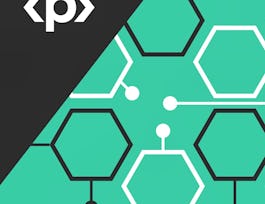This course teaches learners (industry professionals and students) the fundamental concepts of parallel programming in the context of Java 8. Parallel programming enables developers to use multicore computers to make their applications run faster by using multiple processors at the same time. By the end of this course, you will learn how to use popular parallel Java frameworks (such as ForkJoin, Stream, and Phaser) to write parallel programs for a wide range of multicore platforms including servers, desktops, or mobile devices, while also learning about their theoretical foundations including computation graphs, ideal parallelism, parallel speedup, Amdahl's Law, data races, and determinism.



Parallel Programming in Java
This course is part of Parallel, Concurrent, and Distributed Programming in Java Specialization

Instructor: Vivek Sarkar
Sponsored by Louisiana Workforce Commission
48,765 already enrolled
(1,219 reviews)
Skills you'll gain
Details to know

Add to your LinkedIn profile
4 assignments
See how employees at top companies are mastering in-demand skills

Build your subject-matter expertise
- Learn new concepts from industry experts
- Gain a foundational understanding of a subject or tool
- Develop job-relevant skills with hands-on projects
- Earn a shareable career certificate


Earn a career certificate
Add this credential to your LinkedIn profile, resume, or CV
Share it on social media and in your performance review

There are 7 modules in this course
Welcome to Parallel Programming in Java! This course is designed as a three-part series and covers a theme or body of knowledge through various video lectures, demonstrations, and coding projects.
What's included
1 video5 readings1 programming assignment1 discussion prompt
In this module, we will learn the fundamentals of task parallelism. Tasks are the most basic unit of parallel programming. An increasing number of programming languages (including Java and C++) are moving from older thread-based approaches to more modern task-based approaches for parallel programming. We will learn about task creation, task termination, and the “computation graph” theoretical model for understanding various properties of task-parallel programs. These properties include work, span, ideal parallelism, parallel speedup, and Amdahl’s Law. We will also learn popular Java APIs for task parallelism, most notably the Fork/Join framework.
What's included
7 videos6 readings1 assignment1 programming assignment
Welcome to Module 2! In this module, we will learn about approaches to parallelism that have been inspired by functional programming. Advocates of parallel functional programming have argued for decades that functional parallelism can eliminate many hard-to-detect bugs that can occur with imperative parallelism. We will learn about futures, memoization, and streams, as well as data races, a notorious class of bugs that can be avoided with functional parallelism. We will also learn Java APIs for functional parallelism, including the Fork/Join framework and the Stream API’s.
What's included
7 videos6 readings1 assignment1 programming assignment
Join Professor Vivek Sarkar as he talks with Two Sigma Managing Director, Jim Ward, and Software Engineers, Margaret Kelley and Jake Kornblau, at their downtown Houston, Texas office about the importance of parallel programming.
What's included
2 videos1 reading
Welcome to Module 3, and congratulations on reaching the midpoint of this course! It is well known that many applications spend a majority of their execution time in loops, so there is a strong motivation to learn how loops can be sped up through the use of parallelism, which is the focus of this module. We will start by learning how parallel counted-for loops can be conveniently expressed using forall and stream APIs in Java, and how these APIs can be used to parallelize a simple matrix multiplication program. We will also learn about the barrier construct for parallel loops, and illustrate its use with a simple iterative averaging program example. Finally, we will learn the importance of grouping/chunking parallel iterations to reduce overhead.
What's included
7 videos6 readings1 assignment1 programming assignment
Welcome to the last module of the course! In this module, we will wrap up our introduction to parallel programming by learning how data flow principles can be used to increase the amount of parallelism in a program. We will learn how Java’s Phaser API can be used to implement “fuzzy” barriers, and also “point-to-point” synchronizations as an optimization of regular barriers by revisiting the iterative averaging example. Finally, we will also learn how pipeline parallelism and data flow models can be expressed using Java APIs.
What's included
7 videos7 readings1 assignment1 programming assignment
The next two videos will showcase the importance of learning about Concurrent Programming and Distributed Programming in Java. Professor Vivek Sarkar will speak with industry professionals at Two Sigma about how the topics of our other two courses are utilized in the field.
What's included
2 videos1 reading
Instructor

Offered by
Why people choose Coursera for their career




Learner reviews
1,219 reviews
- 5 stars
69.07%
- 4 stars
22.80%
- 3 stars
6.56%
- 2 stars
1.14%
- 1 star
0.41%
Showing 3 of 1219
Reviewed on Jun 18, 2018
Excellent Course.I always wanted a good course on java concurrency and parallel programming.And finish->async, isolated, forAsync constructs are awesome.I have learnt much from this course.
Reviewed on Oct 13, 2020
great course over here it has been great interacting with a simplified course where every complex thing has been narrowed down to easily understandable concepts
Reviewed on Dec 26, 2017
Very relevant concepts, explained beautifully by a very experienced professor. The assignments were good, but they could involve more programming for more practice!
Recommended if you're interested in Computer Science

University of California San Diego

École Polytechnique Fédérale de Lausanne

Open new doors with Coursera Plus
Unlimited access to 10,000+ world-class courses, hands-on projects, and job-ready certificate programs - all included in your subscription
Advance your career with an online degree
Earn a degree from world-class universities - 100% online
Join over 3,400 global companies that choose Coursera for Business
Upskill your employees to excel in the digital economy




